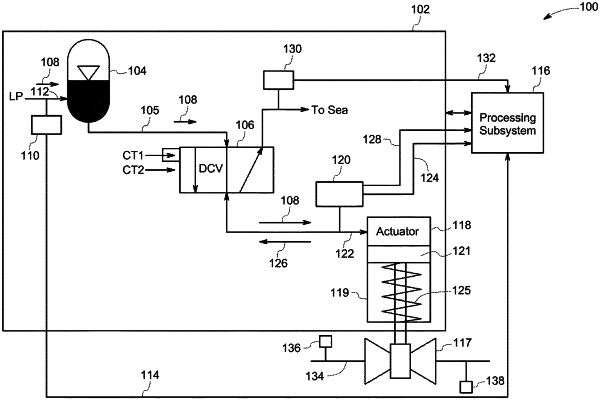| CPC F15B 19/005 (2013.01) [F15B 11/10 (2013.01); F16K 37/0083 (2013.01); F16K 37/0091 (2013.01); F15B 20/005 (2013.01); F15B 2211/212 (2013.01); F15B 2211/6306 (2013.01); F15B 2211/6309 (2013.01); F15B 2211/6313 (2013.01); F15B 2211/6326 (2013.01); F15B 2211/6336 (2013.01); F15B 2211/634 (2013.01); F15B 2211/7052 (2013.01); F15B 2211/855 (2013.01); F15B 2211/857 (2013.01); F15B 2211/864 (2013.01); F15B 2211/87 (2013.01)] | 20 Claims |

|
1. A method for monitoring health of a hydraulic fluid subsystem, the method comprising:
determining a plurality of forces acting on an actuator of the hydraulic fluid subsystem, the plurality of forces being generated, at least in part, by a valve control system comprising:
an accumulator fluidly coupled to the actuator;
a directional control valve within a flow path between the accumulator and the actuator;
a first sensor associated with the accumulator;
a second sensor along the flow path between the directional control valve and the actuator; and
a third sensor associated with an outlet flow path of the directional control valve;
generating a plurality of dynamic equations based on the plurality of forces and one or more of an actuator inlet flow rate, an actuator outlet flow rate, an area of a cylinder of the actuator, a volume of the cylinder, a damping coefficient of the cylinder, and a stiffness of a spring in the cylinder;
generating, from at least some of the plurality of dynamic equations, a plurality of parameters associated with operation of the actuator;
receiving a valve inlet pressure of one or more of oil and gas flowing through a pipe while entering a valve operationally coupled to the actuator, and a valve outlet pressure of the one or more of the oil and the gas flowing through the pipe while flowing out of the valve;
determining, based at least on the plurality of forces acting on the actuator, the valve inlet pressure, the valve outlet pressure, and at least some of the plurality of parameters, that a first likelihood of one or more defects in a component of the hydraulic fluid system is below a threshold;
communicating absence of the one or more defects;
monitoring, after communicating the absence of the one or more defects, the health of the hydraulic fluid subsystem based, at least, on the plurality of forces acting on the actuator and at least some of the plurality of parameters;
determining, after monitoring the hydraulic fluid subsystem for a period of time after communicating the absence of the defect, and based at least on the plurality of forces acting on the actuator, the valve inlet pressure, the valve outlet pressure, and at least some of the plurality of parameters, that a second likelihood of one or more defects in the component of the hydraulic fluid system is above a threshold;
determining, based at least on one or more selected parameters, of the plurality of parameters used to determine the presence of the one or more defects, that the one or more defects is associated with the actuator;
responsive to determining the one or more defects is associated with the actuator, identifying a cause of the one or more defects based, at least, on the valve inlet pressure, the valve outlet pressure, and a portion of the one or more selected parameters;
generating an alarm to inform a user of the one or more defects in semi real time or real time; and
causing, responsive to the alarm, execution of a corrective action to repair the one or more defects.
|